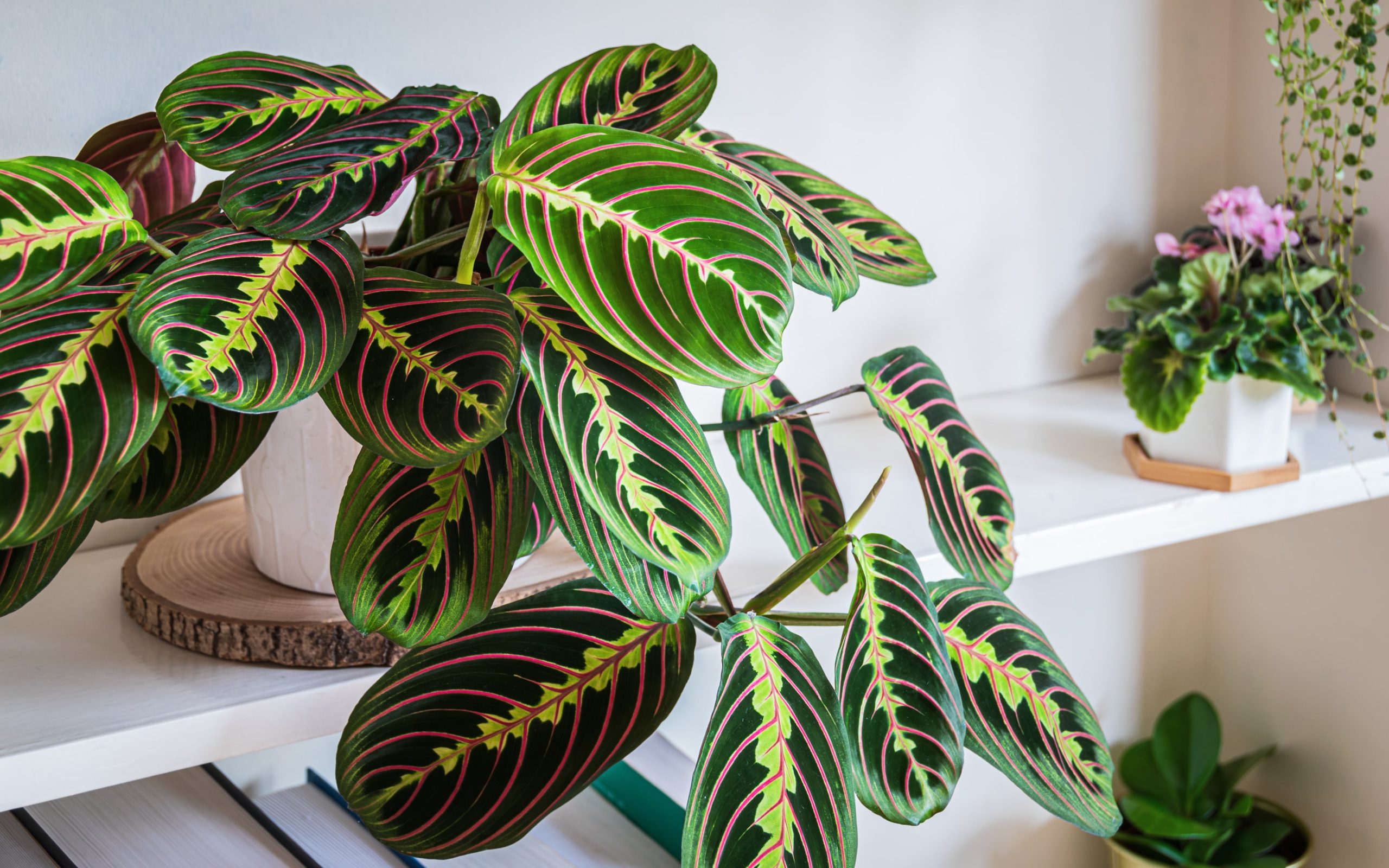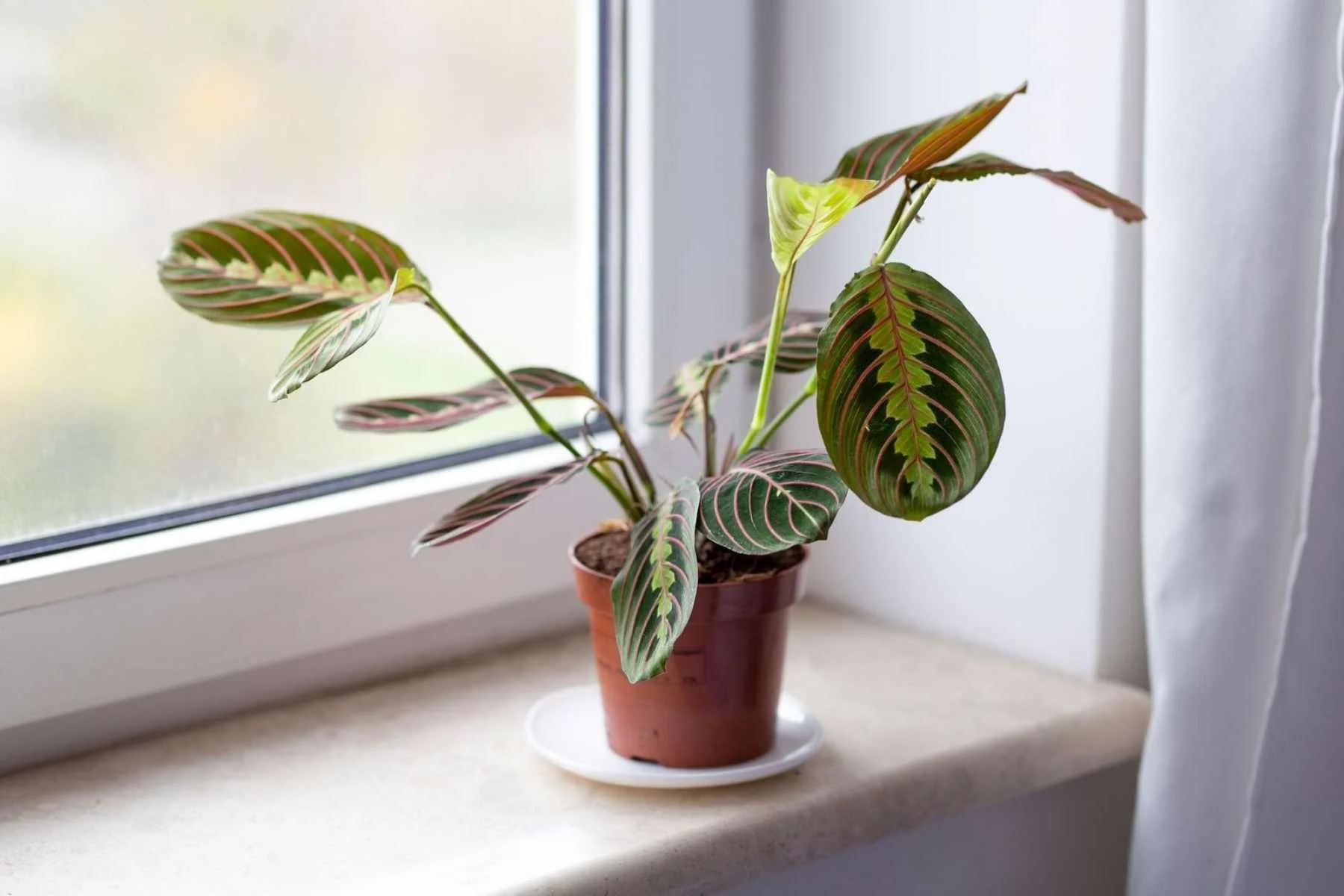If you’ve ever heard that Prayer Plants (Maranta, Calathea, Ctenanthe, and Stromanthe) are impossible to keep alive, think again! 🌿 These stunning houseplants may have a reputation for being fussy, but the truth is—they just want the right care. And trust us, once you master their needs, your Prayer Plant will thrive with mesmerizing leaf movements, vibrant patterns, and pet-safe nature. 🐶🐱

At DH Garden Centre, we’re all about helping you grow happy, thriving Prayer Plants in Canada—yes, even through the dry winters! Ready to crack the code on Prayer Plant care? Let’s dive in!
🌱 Why You Should Love Prayer Plants
Prayer Plants are not just pretty—they’re fascinating! Their leaves move up and down throughout the day, responding to light like they’re in meditation. This natural movement, called nyctinasty, makes them one of the most unique houseplants you can own. But beyond their mesmerizing movements, they offer a wide range of benefits that make them a must-have in your home.
✅ Breathtaking Foliage – Nature’s Living Artwork
Each variety of Prayer Plant boasts incredible foliage that looks almost painted by hand. From the striking pink and purple hues of Calathea Roseopicta to the intricate fishbone patterns of Ctenanthe Setosa. Their vibrant colors and bold markings add an artistic, tropical touch to any indoor space. Their leaf undersides often feature deep burgundy, red, or purple tones, creating a mesmerizing contrast as they move. Whether you choose a compact Maranta Lemon Lime or a dramatic Stromanthe Triostar, these plants bring visual intrigue to your home.

✅ Pet-Safe – The Perfect Houseplant for Animal Lovers
Unlike many tropical houseplants that are toxic to pets, Prayer Plants are completely safe for cats and dogs. If you’ve been hesitant about bringing houseplants into your home due to your furry friends, this is one of the best choices for a pet-safe indoor garden. No need to worry about accidental nibbles—just enjoy the beauty of your Prayer Plant without concerns.

✅ Low Light Tolerant – Thrives Even in Dim Rooms
Many people struggle to find plants that thrive in areas with limited natural light. The good news? Prayer Plants are well-adapted to low-light conditions because they naturally grow in the understory of tropical rainforests. They prefer bright, indirect light, but they can also survive in lower light settings—making them perfect for apartments, offices, and rooms with few windows.
✔️ Place them in east-facing windows for gentle morning sunlight.
✔️ If using a south or west-facing window, keep them away from direct sun by filtering the light with sheer curtains.
✔️ In low-light spaces, supplement with a grow light to maintain their vibrant foliage.

✅ Humidity Lovers – Naturally Improve Indoor Air Quality
Struggling with dry indoor air? Prayer Plants thrive in humid environments, making them excellent natural humidity indicators. When the air is too dry, their leaves curl and develop crispy brown edges—a signal that your indoor air could use a boost.
✔️ Increase humidity by grouping plants together, which creates a microclimate.
✔️ Use a humidifier to maintain levels above 50-60% for optimal growth.
✔️ Misting occasionally can provide a quick boost, but avoid excessive misting to prevent fungal issues.
✔️ Pebble trays filled with water can help raise humidity naturally.
✔️ Consider placing them in a bathroom with bright, indirect light where they’ll benefit from shower humidity.
Beyond maintaining humidity, Prayer Plants are also known to purify indoor air by absorbing toxins such as formaldehyde and benzene. By keeping them in your home, you’re not only adding a gorgeous green touch but also promoting a healthier living environment.
🌿 Pro Tip: If you notice crispy leaf edges, check both humidity and water quality—switching to filtered or distilled water can help prevent browning caused by tap water minerals.

☀️ The Lighting Myth: Why Bright Light Can Harm Your Prayer Plant
If you’ve placed your Prayer Plant in a sunny window, you might be unknowingly stressing it out! These houseplants naturally grow on the forest floor, shaded by tall trees where they receive only filtered or dappled sunlight. Harsh, direct rays can scorch their delicate leaves, leading to brown spots and crispy edges.
Optimal Lighting Conditions:
- East-Facing Windows: Perfect for soft morning light that’s gentle on your Prayer Plant’s foliage.
- North-Facing Windows: Provides cool, indirect light throughout the day, ideal for maintaining vibrant leaf patterns.
- South or West-Facing Windows: Keep your plant at least 10 feet away from direct sun or use sheer curtains to diffuse the light.
- Low-Light Rooms: Yes, Prayer Plants can tolerate lower light levels, but consider adding LED grow lights if they start looking leggy or lose color.
Pro Tip: If your Prayer Plant’s leaves are fading, moving less, or growing leggy, it’s a sign they need a brighter spot with indirect sunlight. Adjust their placement to find the sweet spot!

💦 Watering: Avoid the Root Rot Trap!
Prayer Plants love moisture but hate soggy roots. Many plant parents overwater in an attempt to keep their plants happy—only to end up with root rot and wilting foliage.
Effective Watering Techniques:
- Check the Soil: Insert your finger into the top 2-3 inches of soil. If it’s dry to the touch, it’s time to water.
- Use Distilled or Filtered Water: Tap water’s chlorine, fluoride, and minerals can lead to brown leaf tips and crispy edges.
- Water Thoroughly: Give enough water so it drains out the bottom. Never let the plant sit in standing water, as this can suffocate the roots.
- Winter Rule: During colder months, your Prayer Plant’s growth slows—reduce watering accordingly.
Pro Tip: Bottom-watering (placing the pot in a tray filled with water) ensures even moisture distribution and prevents overwatering. Perfect for avoiding root rot!
🌡️ Humidity & Temperature: The Secret to Avoiding Crispy Leaves
If your Prayer Plant’s leaves are curling, browning, or developing crispy edges, low humidity could be the culprit. These tropical houseplants crave a jungle-like environment—but no greenhouse is required!
Boosting Humidity Naturally:
- Group Houseplants Together: Create a mini rainforest effect by clustering multiple plants.
- Pebble Tray: Place your pot on a tray filled with pebbles and water to raise surrounding humidity.
- Bathroom Placement: An east or north-facing bathroom window provides humidity from showers and gentle light.
- Humidifier: Aim for 50-60% humidity to keep leaves plump and vibrant.

Temperature Tips:
- Keep Above 18°C (65°F): Anything lower can stunt growth or cause leaf discoloration.
- Avoid Drafts: Heaters, air conditioners, and drafty windows can dehydrate leaves quickly.
- Dormancy in Winter: If your plant stops growing, don’t fret. Reduce watering and fertilizing until spring.
Pro Tip: For best results, monitor humidity levels with a hygrometer. Prayer Plants thrive in moderate to high humidity, making them a perfect choice for kitchens and bathrooms!
🌿 Soil & Repotting: Give Their Roots Room to Breathe
Prayer Plants have delicate roots, so the right potting mix is essential for healthy growth. They thrive in well-draining soil that retains enough moisture to keep roots hydrated—without causing waterlogged conditions.
Ideal Soil Composition:
- 40% High-Quality Potting Soil: Provides nutrients and a stable base.
- 30% Perlite: Ensures good drainage and prevents compacted soil.
- 20% Orchid Bark: Enhances aeration and mimics the loose, natural substrate of tropical rainforests.
- 10% Charcoal: Helps filter excess moisture and prevents bacterial growth.
Repotting Guidelines:
- When to Repot: Only when the plant is root-bound—typically every 1-2 years. Look for roots poking out of drainage holes.
- Gentle Transfer: Prayer Plants dislike having their roots disturbed, so handle them carefully.
- Choose the Right Pot: Go up just one pot size to avoid overpotting and potential root rot.
Pro Tip: If your Prayer Plant’s growth slows or leaves become smaller, peek at the roots. Root-bound plants need extra room to expand and absorb nutrients!
✂️ Pruning & Propagation: Multiply Your Prayer Plant Collection!
Give your Prayer Plant the occasional trim to keep it healthy and encourage lush, new growth. Pruning also maintains a tidy shape and prevents energy waste on dying leaves.
Pruning Tips:
- Remove Yellow/Dead Leaves: Prune spent or damaged foliage at the base to redirect nutrients to healthier parts.
- Control Legginess: Trim back leggy stems just above a node to encourage bushier growth.
Propagation Methods:
- Stem Cuttings (Marantas & Ctenanthe): Cut below a node and place in water or moist sphagnum moss until roots form. Transfer to a well-draining potting mix once roots are established.
- Division (Calatheas & Stromanthe): Gently separate the root clump during repotting—ensure each division has healthy roots and foliage.
Pro Tip: Spring is the ideal time to propagate Prayer Plants—longer daylight hours and warmer temperatures promote faster rooting!
Final Thoughts: Transform Your Home with Thriving Prayer Plants
By perfecting the balance of lighting, watering, humidity, and soil, you’ll cultivate a Prayer Plant that’s brimming with color and life. These pet-safe, low-light tolerant houseplants are not only beautiful but also air-purifying, making them a smart choice for any indoor space—especially in Canadian homes where winters can be harsh.
Ready to add a Prayer Plant to your collection? Visit DH Garden Centre in Vancouver or shop online for high-quality plants, expert advice, and all the supplies you need to keep your indoor garden flourishing year-round.
🌿 Looking to add a Prayer Plant to your collection? Visit DH Garden Centre in Vancouver or shop online for the best selection of healthy, thriving Prayer Plant and expert advice!



